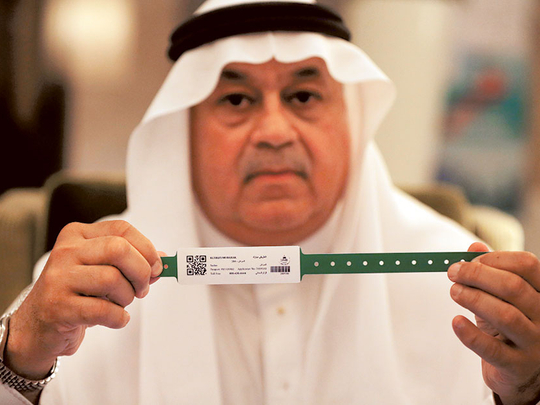
Makkah: Saudi Arabia has begun issuing Haj pilgrims with identification bracelets one year after a stampede killed around 2,300 people.
The bracelets are a reassurance to some pilgrims.
Public statements and Saudi press reports show that changes have been made after last year’s crush to prevent overcrowding even though no one was ever blamed for the tragedy.
After the disaster — the worst in Haj history — some foreign officials expressed concern about difficulties in identifying the dead.
Each plasticised paper bracelet carries a bar code readable by smartphone. It indicates the pilgrim’s identity, nationality and place of lodging in Makkah.
Additional data includes a contact in the pilgrim’s delegation and details provided when his or her visa was issued, the vice-secretary of the ministry of Haj and umrah, Eissa Rawas, said.
“The aim is to equip all pilgrims” from abroad, who are expected to number more than 1.4 million, he said.
Rawas did not specify the number of bracelets issued so far. Their distribution has not been systematic ahead of the formal start of the Haj on Saturday.
In the crowds that fill the Grand Mosque and its surroundings day and night, numerous pilgrims were seen wearing bracelets.
But some were issued by travel agents and don’t include the information stored in the government’s bracelet.
Nabil Melhem, 61, a Palestinian bricklayer, wears one of the official bracelets, which he said cost about two riyals (Dh1.96).
It is “like a passport,” said Melhem, from the Israeli-occupied West Bank.
The bracelet is two centimetres (almost an inch) wide and coloured green for pilgrims from Arab countries.
“If we get lost, if we die, if we are sick or unable to talk, they can contact our delegation, thanks to the bracelet,” he said.
Drissa Conakry, a Nigerian pilgrim, said hotel staff “put this bracelet on us as soon as we arrived”.
Conakry, 30, a teacher, said the bracelet, coloured mauve for African pilgrims, provides a measure of comfort.
“I tell myself that, at least, I am identified.”
Behind her, four Australian pilgrims move closer, intrigued by the device. They say they have not received the bracelets.









